Aleurodids (Aleyrodidae), or whiteflies, are a family of small homoptera insects, which unites more than one and a half thousand species. The scientific name of this family, derived from the Greek word, is translated as "flour", and this is due to the fact that there is a powdery coating on the surface of the wings of such an insect. Whitefly is a very dangerous insect that can seriously harm both indoor and garden crops. Also, this pest is able to penetrate the greenhouse.
Content
Whitefly features
Despite the fact that there are a huge number of whitefly species, the length of this insect varies from 0.13 to 0.3 cm. Outwardly, it is similar to a molar lepidoptera. On the surface of the reddish-yellow body there are small spots of a dark color, the whitefly has four wings, and they fold like a house, on their surface there is a powdery white dusty coating. Young larvae are very mobile, and they use the sap of various plants as food. Over time, they attach to the seamy surface of the sheet plates. Some species of whiteflies are dangerous quarantine pests.
You can understand that the plant is occupied by a whitefly by the following signs:
- when you touch the plant, white midges fly up from it, which outwardly look like a very small moth;
- on the seamy surface of the foliage, translucent scales have formed, which are pest larvae;
- on the shoots and foliage, chlorotic spots of yellow color are formed, and then a sticky bloom appears, which is a honeydew, or honeydew (this is a waste product of a whitefly);
- plant growth and development slows down.
This pest prefers warmth and high humidity, which is why it reproduces well in greenhouses and greenhouses. Already at 10 degrees, the whitefly dies, but its eggs calmly withstand even winter frosts. This most dangerous pest is also one of the main carriers of fungal and even viral diseases (for example, curl, gray rot, mosaic, powdery mildew, etc.), which are currently considered incurable.
Prevention measures
Experienced gardeners and gardeners know that it is much easier to prevent the appearance of a pest on their site than to fight it for a long time and persistently. In this regard, preventive measures play an important role in the fight against whitefly:
- Systematically inspect the crops, while especially carefully inspecting the seamy surface of the leaf plates, since the pest loves to hide and lay eggs there. Remember that crops growing in conditions of high humidity and high temperatures need special attention.
- Feed the plants in a timely manner and provide them with good care, since first of all pests affect weakened specimens.
Ways to combat whitefly in a greenhouse
Whitefly remedies (drugs)
If you have tried all the possible ways to combat a whitefly that has settled in a greenhouse, and they turned out to be ineffective, only then experts advise you to resort to the use of chemicals. Of course, pesticides are much more effective than folk remedies, but they are very toxic.
The following insecticidal preparations fight the whitefly most effectively:
- Aktara... It is a systemic agent of prolonged action (3-5 weeks). A solution is prepared from it, which is poured under the root of the bush, but if there are a lot of pests, then it is used to process the foliage from a spray bottle. If necessary, 2 more treatments are carried out with a break of 7 days. However, experienced summer residents are advised to get rid of the whitefly in one go, for this you need a concentrated solution of the drug (three or four times stronger than recommended in the instructions).
- Confidor... The drug has a contact-systemic action, after treatment with which harmful insects die within 1.5 hours. The active substance contributing to the death of whiteflies in various concentrations is also available in the following products: Copfidor, Gaucho, Admir, Marathon, Commander, Provado and Applound.
- Akarin (Agravertine)... This contact-intestinal insect-acaricidal preparation is used in the fight against many harmful insects, as well as arachnids. A solution of the agent is sprayed on the foliage of the crops, and it is necessary that it must fall on the pest.
- Spark (Bio, Gold, Double Effect)... Such a tool is very effective, it is able to exterminate all pests after the first treatment. On sale in the store, this drug is available in the form of water-soluble tablets, sticks, long-acting sticks, powder and ampoules. After watering, the agent penetrates into the root system and tissues of the bush, where it can stay for up to 20 days, while poisoning both adults and pest larvae.
- Fitoverm... An insectoacaricidal drug is used in the fight against almost all pests. The solution prepared from it is sprayed on the bushes over the foliage 1 or 2 times. Most often, such a number of treatments is enough to exterminate the entire pest population.
- Actellic... Insectoacaricidal drug used in the fight against ticks and insects. Remember that the smell of this product is very strong and unpleasant, and it is also highly toxic. In this regard, experts recommend using it outdoors, and do not forget about the precautions.
- Tanrek... This insecticidal preparation has a contact-intestinal effect, while it is very effective in the fight against various harmful insects. Such a remedy also effectively copes with whitefly, especially on crops with smooth leaf plates without pubescence. If there is pubescence on the foliage, then it is best to use a fine spray to spray it.
Also summer residents in the fight against whitefly very often use the following means: Fufanon, Alatar, Top-star, Rovikurt, Inta-Vir, Zeta, Pyrethrum, Fury, Talstar, Cypermethrin, Neudosan, Ekamet, Decis, Ambush, Arrivo, etc.
Whitefly on tomatoes in a greenhouse
In summer, whiteflies are most often found on crops grown outdoors. However, with the onset of autumn, when it gets significantly colder, they try to move to greenhouses, greenhouses or living quarters.
You can understand that whiteflies have settled on tomatoes by the blurry specks of yellow color and sticky secretions that appear on the foliage. Conduct a mandatory inspection of the seamy surface of the leaf plates, if you see colonies of this pest on it, then you need to start fighting it as soon as possible.
In order to exterminate the whitefly that has settled on greenhouse tomatoes, it is necessary to rinse the leaf plates with a soap solution with particular care (pay special attention to the seamy surface of the leaves). Wash the soap off the plants after 60 minutes. Thanks to this procedure, tomatoes will be able to breathe easier. But in order to preserve the harvest, you will have to repeat this procedure many times. Also, this harmful insect is fought with glue traps (for example, from Bona Forte), and they should be evenly distributed over the entire area of the greenhouse. You can also reduce the number of adults using sticky tapes for Moskitol or Fumitox flies, which are covered with a special compound. But such traps are effective only against adults. In order to get rid of whitefly larvae on tomatoes, use a garlic solution or an infusion prepared from the rhizome of medicinal dandelion.
If there are a lot of whiteflies in the greenhouse, then you cannot do without the use of pesticides. To increase the effectiveness of any of the chemical preparations, it is recommended to use the so-called "sticking agent": a small amount of liquid dishwashing detergent, ground household or insecticidal soap, or shampoo, is added to the pesticide solution. In large greenhouses, whiteflies are fought with the help of encarsia - these are predatory parasitic entomophages (one individual is enough for 1 square meter).
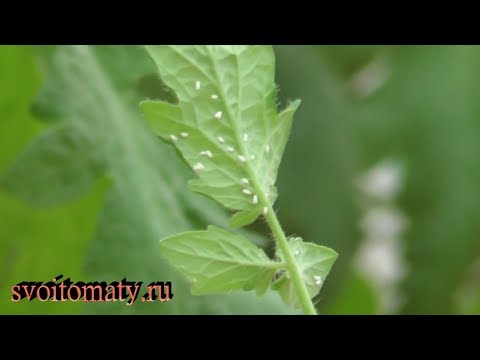

Watch this video on YouTube
Whitefly on cucumbers in a greenhouse
Greenhouse cucumbers can be severely affected by both whitefly larvae and adults. To obtain a powerful and quick effect, the bushes are recommended to be treated 1 or 2 times with a chemical agent. If there are not very many pests, then you can try to get rid of them with the help of more harmless folk remedies, but at the same time be prepared to process cucumbers several times. Remember that it will not work to exterminate a whitefly that has settled in a greenhouse with a pesticide or folk remedy. Next year, she can settle in the bushes again. That is why experts do not advise neglecting preventive measures.
The signs of the appearance of this pest on cucumbers are the same as on tomatoes:
- leaf plates become discolored, begin to curl and fade;
- sticky, as well as blurry yellow spots and whitish dots form on the foliage;
- there are larvae on the seamy surface of the foliage.
If you move the bush, you can see how small white moths, which outwardly look like moths, fly from it in different directions. If there are still few pests, then folk remedies can be used to combat it. But be prepared for the fact that you will have to carry out treatments regularly once a week until absolutely all pests in the greenhouse die. During processing, be sure to thoroughly moisten the seamy surface of all sheet plates. You can also try to get rid of pests with a soap solution. To do this, a sponge is moistened in it, with which all areas where there are larvae are washed.The main advantage of this method is that after processing you will remove not only the larvae, but also the sooty fungus, due to which the pores of the leaf plates will open and they will be able to breathe normally. If there are a lot of whiteflies, then the following pesticides are used to destroy them: Fufanon, Detis, Aktaru or Verticillin (be sure to follow the manufacturer's instructions). To reduce the number of adult insects in the greenhouse, sticky tapes are hung. However, it is most effective and safe to use insects that eat the eggs of this pest.
Whitefly in the garden (in the open field)
Whitefly on tomatoes
Signs that whiteflies have settled on tomatoes growing in the open are the same as those of greenhouse tomatoes. And in both cases, this dangerous pest is fought in almost the same ways. Most importantly, remember that you need to use chemicals only when treatments with folk remedies turned out to be ineffective. Also, the use of pesticides is justified in the event that there is a real threat to lose the entire crop.
In order to prevent the appearance of a whitefly on the site, one should not forget about the following preventive measures:
- For planting in open ground, only those seedlings are used that have no symptoms of diseases and pests.
- Systematically clear the area of weeds, while keeping in mind that the whitefly loves runny and nettles the most.
- To catch flying whiteflies, glue traps are hung up.
If you find a pest on seedlings, then it is recommended to spray them 1 time with one of the above chemicals or to carry out several treatments with a folk remedy. Then the seedlings can be planted in open ground. If insects have settled on bushes planted in a garden bed, then it is recommended to fumigate them with sulfur, which can destroy both larvae and adult pests. Instead, plants can be systematically sprayed once a week with a folk remedy. If there are a lot of harmful insects on tomatoes, then it is recommended to treat them with a powerful toxic chemical (for example: Fufanon or Mospilan). Plants are processed on a cloudy and windless day, but there should be no rain. Also remember that the whitefly has the ability to develop resistance to pesticides, so do not forget to alternate them.
Whitefly on cucumbers
For cucumbers grown in the open field, whiteflies are very dangerous. Also remember that they are one of the main carriers of dangerous diseases, for example: chlorosis, yellow cucumber mosaic, fruit necrosis, curly foliage and jaundice. As soon as the first signs of the presence of a whitefly are found on the bushes, you need to immediately begin to combat it. The fact is that this insect is very fertile: during one month of her life, the female is able to lay about 130 eggs.
This pest is fought on cucumbers in the same ways as on other crops, namely: folk remedies, pesticides and a mechanical method. However, prevention has shown the greatest efficiency in the fight against whiteflies. If you take all the necessary preventive measures in a timely manner, then your cucumbers will be reliably protected from this dangerous insect. But if you failed to protect the plantings, and the pest nevertheless settled on them, then immediately after its detection, thoroughly rinse the foliage with a soap solution, and after 1 hour rinse them with clean water. Then manually remove the larvae from the seamy surface of the leaf plates and loosen the ground to a depth of 20 to 30 mm. This procedure must be carried out repeatedly.
The most effective of folk remedies with this pest fights an infusion of dandelions and a garlic solution. In order to reduce the number of whitefly individuals, it is recommended to spray the bushes with a solution of the Bud preparation once every one and a half weeks.And of the pesticides, the most effective in the fight against this insect are Iskra and Tsitkor. The foliage should be processed on a cloudy, windless day, but there should be no rain. Experts advise alternating chemicals, because this pest can develop resistance to them.


Watch this video on YouTube
Cabbage
If there is a suspicion that a whitefly has settled on the cabbage, then it will be very simple to check this: shake the foliage on the bush, small white moths should immediately soar up from it. Inspect the seamy surface of the leaf plates, if there are translucent larvae on it, then they are removed with a soapy solution and a sponge. Then the bushes are washed with clean water.
You can also try to save cabbage from this dangerous pest using folk remedies. For example, a lot of fly sticky tapes are hung on the lot. Also, the treatment of bushes with infusion of garlic or dandelion foliage and rhizomes shows high efficiency. If necessary, cabbage can be treated with one of the pesticides. Moreover, it should be noted that the most effective in this case are drugs such as Fitoverm, Fufanon, Iskra, Aktara, Aktellik, Confidor and Inta-Vir.
Strawberry
You can understand that whiteflies have settled on strawberries by the following signs: a white bloom forms on its foliage, and a slowdown in plant growth and its wilting is also observed. Examine the lower surface of the leaf plates, if there are larvae, then start fighting them. First, the affected bushes must be washed with a concentrated solution of laundry soap or flea shampoo. Then they are necessarily rinsed with clean water. Make sticky traps with your own hands, for this take cardboard or plywood and cut it into small pieces. Paint each piece a yellow shade and apply one of the following sticky substances to the surface: petroleum jelly, honey, or castor oil (they must be mixed with a few drops of rosin). Spread these bait traps evenly over the area. Adults attracted by the yellow color stick to the bait. From folk remedies in the fight against whitefly on strawberries, it is recommended to use an infusion prepared from the foliage and roots of dandelion, and a garlic solution is also suitable. Of the pesticides, the most effective in this case will be: Aktellik, PEGAS, Aktara, Confidor or Rovikurt. The biological method also shows a fairly high efficiency: macrofus bugs or encarzia, feeding on whitefly larvae, are settled on the bushes of garden strawberries. After these parasites destroy the whitefly in your area, they will leave it on their own.
Raspberry
Signs that whiteflies are present on raspberries are the same as on other crops: a whitish coating of honeydew forms on the surface of the foliage, which darkens over time due to a sooty fungus. When examining the seamy surface of the foliage, you can find an accumulation of adults and their larvae.
In order to get rid of the pest, it is first recommended to use more harmless folk remedies. And only if they turn out to be ineffective, chemical preparations are used to combat whiteflies.
Grapes
If whiteflies have settled on the grapes, then the bushes should be washed with soapy water. After that, they are treated with dandelion infusion or garlic solution. However, the treatment with folk remedies will have to be carried out regularly once a week. After the harvest is harvested, the bushes are treated with a solution of Aktara or Fufanon.
How to get rid of whitefly on indoor flowers
Fuchsia
Whitefly can also live on indoor plants, such as fuchsia. This pest is thermophilic, and fuchsia has a fairly high resistance to cold. Therefore, if you transfer it to a cool balcony and leave it there for a while, this will lead to the death of the pest.Also, to combat this insect, you can use a harmless folk remedy: in 1 tbsp. warm water (about 50 degrees) dissolve 2 tsp. granulated sugar and immediately process the bush with this composition. Of the pesticides, it is best to choose Actellik for processing fuchsia.
Hibiscus
Remember that after settling on an indoor hibiscus, the whitefly can immediately fly to other plants located nearby. In this regard, the fight against the pest must be started as soon as it is detected. In this case, as in all the others described above, a soap solution and dandelion infusion are used. If such folk remedies do not bring the desired result, then the bushes are treated with Aktara's solution.
Whitefly settles on indoor plants no less often than on garden and vegetable garden crops. At home, it very quickly spreads to all plants, and this must be taken into account when choosing a method to combat a pest. Experienced flower growers recommend, first, wash the infected bush with a solution of soap, rinse it thoroughly with clean water, and then spray it with an insecticidal preparation, having previously transferred it to the street.
The simplest pest control methods are effective only at the initial stage of infection. The fact is that they are designed to destroy the usual life cycle of the whitefly.
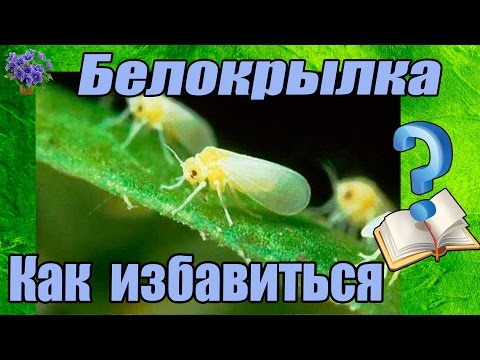

Watch this video on YouTube
Folk remedies
Washing foliage with water
The transformation of larvae into adult insects occurs in 7 days. Until this moment, they, being on the seamy side of the leaf, actively suck the juices out of it. In order to reduce the number of pests, it is necessary to destroy as many larvae as possible. Therefore, once a week, you must thoroughly wipe each leaf with a moistened soft sponge. It is recommended to apply a soapy solution for this. Try to remove any existing larvae from the leaves. After some time, the pests will be completely destroyed.
However, this method is applicable only in the case of a small amount of vegetation. So, for example, in bulk plantings, greenhouses, greenhouses, this method is ineffective and labor-intensive.
Lowering the air temperature to 10 degrees
If the temperature is lowered to 10 degrees or less, then the adults die, but a certain number of larvae and eggs remain alive and simply hibernate. After an increase in temperature of more than 15 degrees, they come to life and continue their normal activities.
Other folk remedies are various solutions with which you should either water the affected plant or spray it.
Tinctures and solutions against whitefly
Soap solution
Laundry or tar soap is suitable for preparing the solution. It should be chopped with a grater. Dissolve the soap in water in a ratio of 1: 6. The resulting liquid must be whipped well to form a stable foam, and then, using a sponge, apply it to the surface of the plant. You can simply spray the green parts of the plant with the resulting solution, and you do not need to whip it. The surface layer of the soil should also be lightly sprayed.
In some cases, all insects will be destroyed after the first treatment. However, in most cases, a new treatment will be required after 7 days.
Garlic infusion
For a liter of clean water, you will need 2 medium-sized minced garlic cloves (6 grams). Mix everything, cover and remove the container in a dark place. After 24 hours, the infusion is filtered and used for spraying. As a rule, 2 or 3 treatments are enough, there should be a break of 1 week between them.
Infusion of Yarrow Herb
For a liter of water, you will need about 90 grams of yarrow leaves (not dried). Mix and leave for 48 hours. Then the infusion must be filtered and the plant can be treated with it using a sprayer. 2 or 3 treatments are enough, the break is 1 week.
Infusion of tobacco
To prepare the infusion, you need to purchase cigarettes (for example, "Primu"). Gut tobacco from cigarettes and pour a liter of not very hot water into it. Remove the mixture in a dark place, and after 5 days the infusion will be ready for use. It needs to be drained and applied for spraying. The treatment is carried out once every three days, until the whiteflies completely disappear.
Dandelion infusion
For cooking, you will need 40 grams of dandelion leaves and the same amount of roots of this plant. They are cut into small pieces and then mixed with a liter of water. After 3 or 4 days, the infusion will be ready. After straining it is used for spraying plants. The treatment is repeated a couple of times, while the interval between them should be a week.
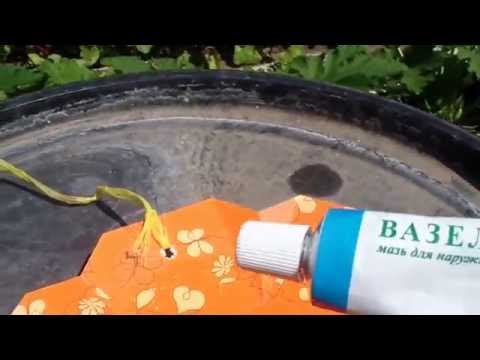

Watch this video on YouTube
Whitefly species
The most studied species of the entire family is the tobacco whitefly, which is one of the dangerous quarantine objects. This insect has spread all over the world. The lifespan of an adult is two weeks, her body is yellow, her legs are yellowish, and her wings are white. One female is capable of laying 50-300 eggs throughout her life. This species settles on melons, industrial, vegetable and flower crops, as well as on forage grasses, medicinal plants and some weed grass. Also, this pest can be found on berry, woody, fruit and citrus plants. This type of whitefly is very dangerous for crops grown in greenhouses or greenhouses.
This harmful insect can transfer from one crop to another about 100 different types of viruses, and because of most of them, the summer resident can lose the entire crop. The biological enemies of the whitefly include predatory bugs, lacewing, and certain types of ladybugs.
In addition to the tobacco whitefly, the following species of the family are also widespread:
- greenhouse whitefly, or greenhouse - such a pest settles on tomatoes, cucumbers and some flower crops;
- cabbage whitefly;
- citrus whitefly - this quarantine harmful insect settles on citrus crops, it can be found in Japan, America, China, India and the Caucasus;
- strawberry whitefly - can be found in Europe.
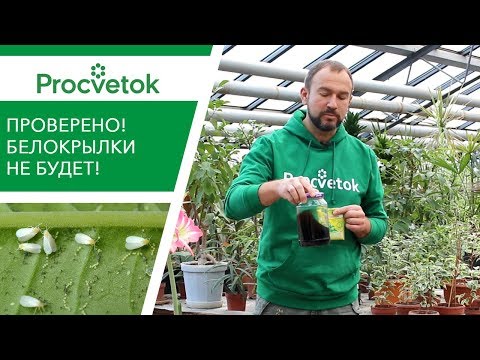

Watch this video on YouTube

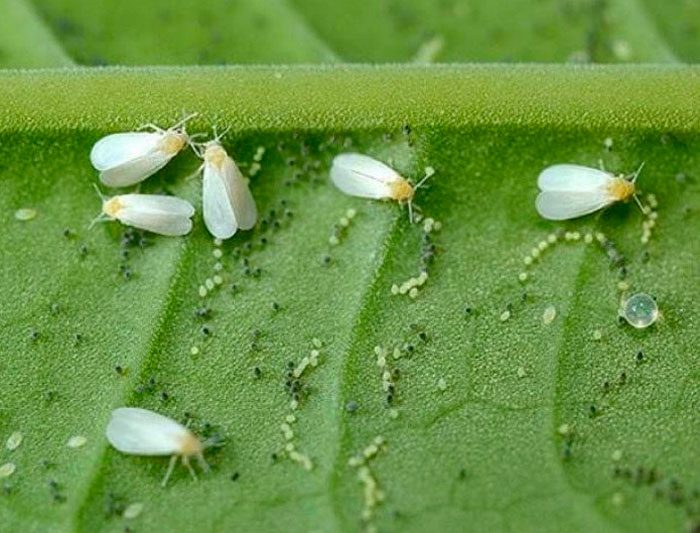
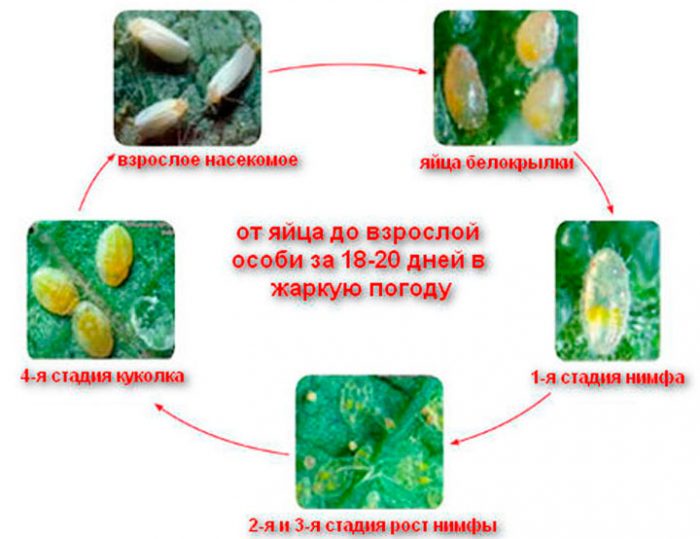
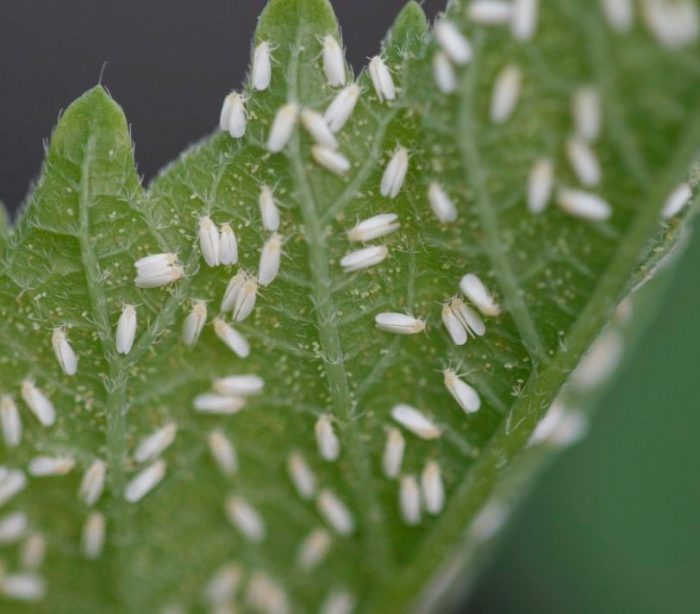
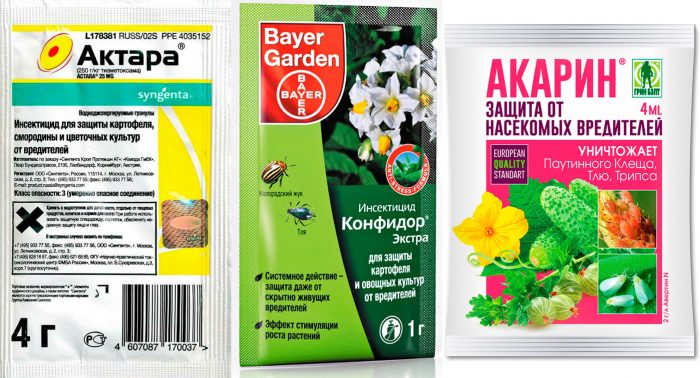
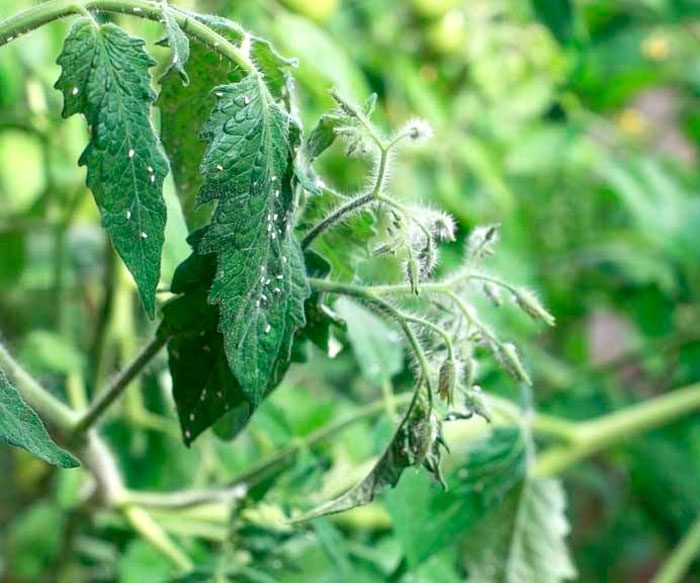
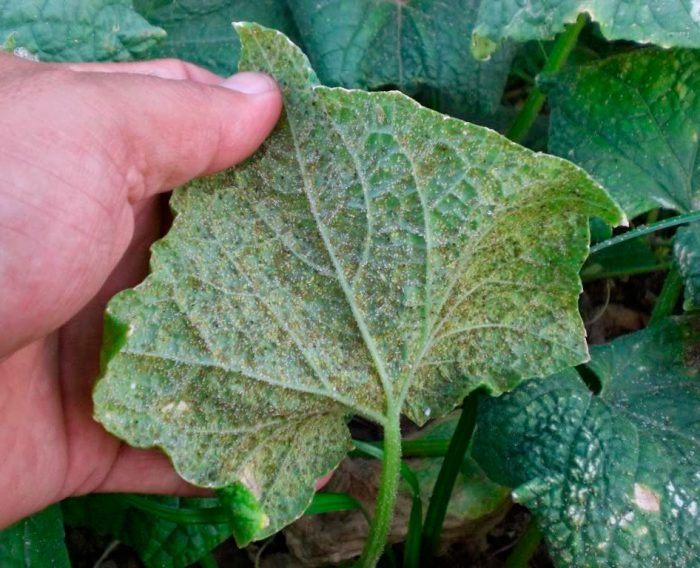
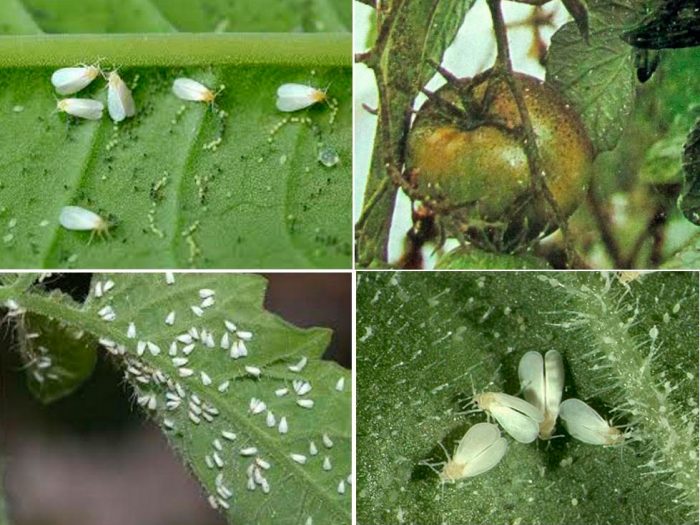
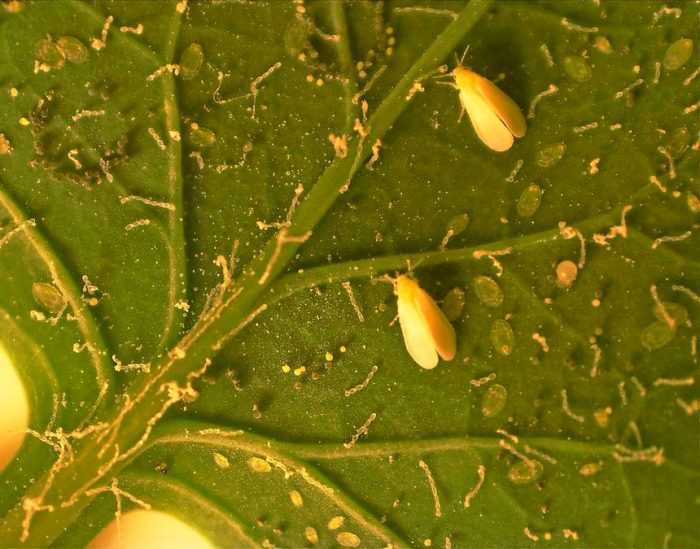
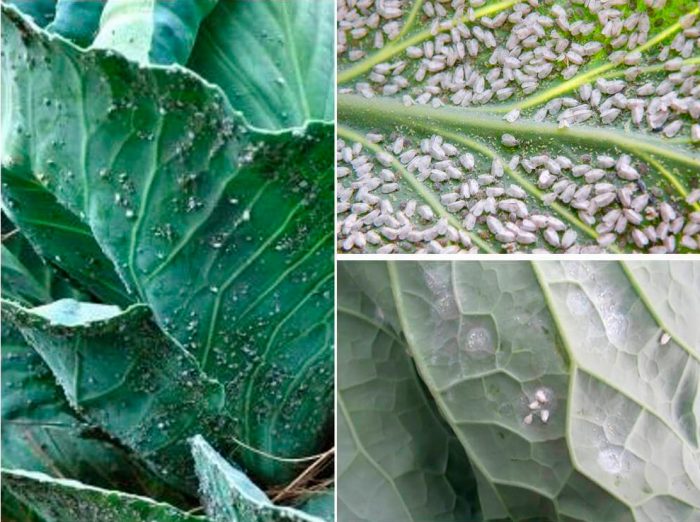
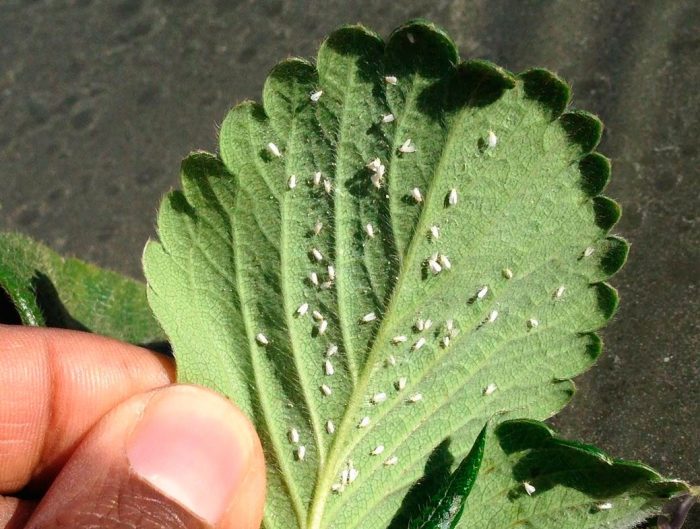
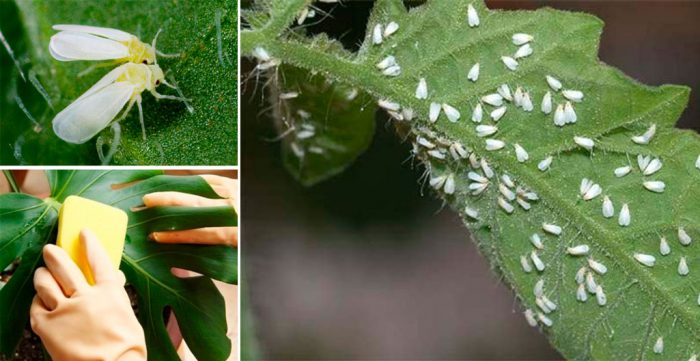
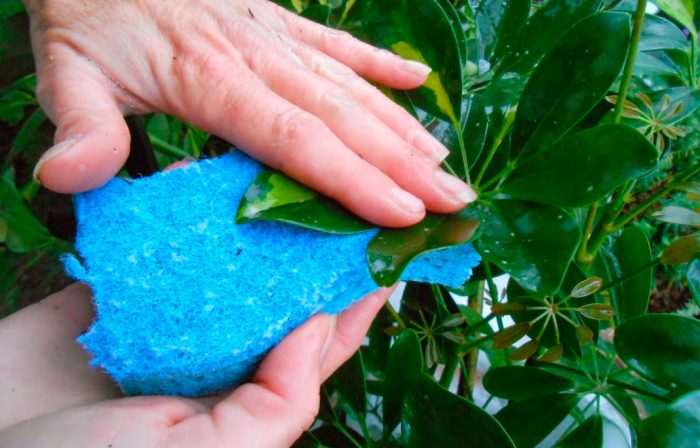
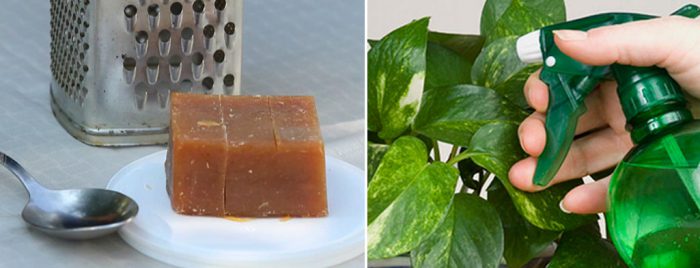
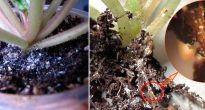

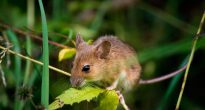

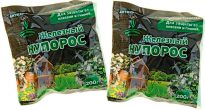

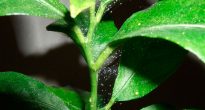



The fact that the whitefly dies at temperatures below 10 degrees-ound. On my balcony for a long time it was below 6 - this is the Polar region - and this muck, albeit with difficulty, but crawled. Now I bought insecticides, I will try everything that suits
To get rid of the whitefly in the greenhouse, I always advise everyone to use such insecticidal checkers as: "Quiet Evening" or "City". At one time, they helped me a lot to get rid of this pest.
Tell me, where is the best place to get them?